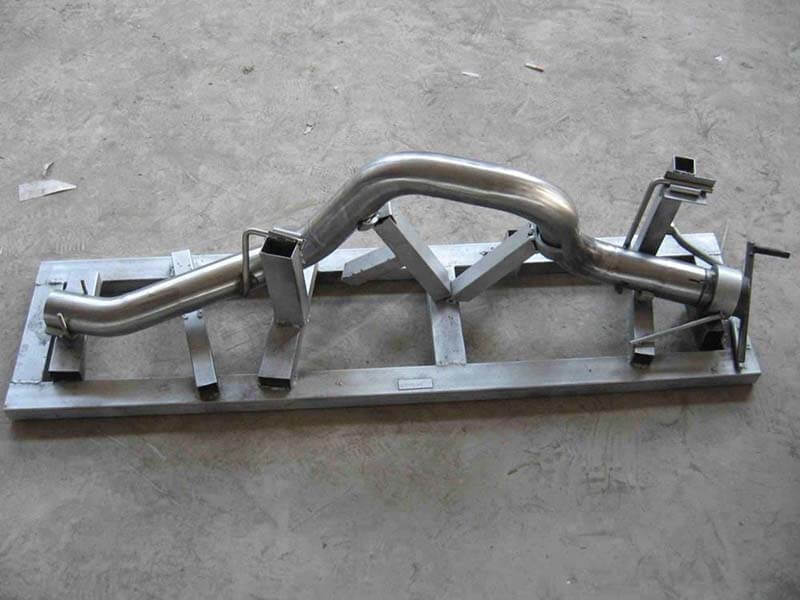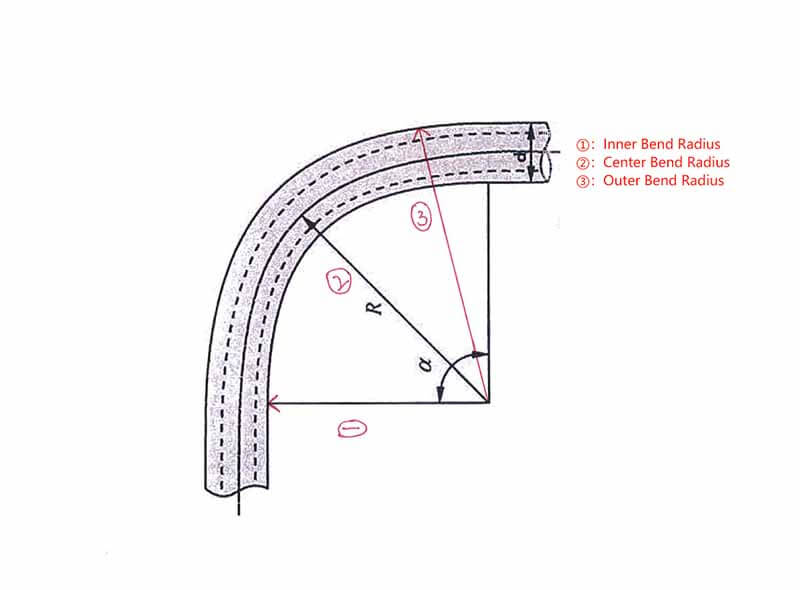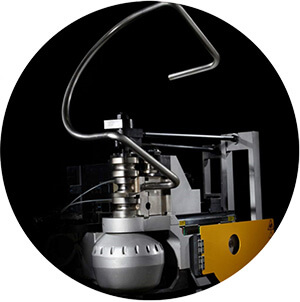Basic Knowledge of Pipe Bending

Pipe bending technology plays a crucial role in modern industry. Whether you are producing exhaust systems, fuel lines, and brake lines for automobile manufacturing, hydraulic systems, fuel delivery systems, and ventilation systems for aircraft manufacturing, pipelines for the oil and gas industry, or chairs, tables, armrests, and bed frames for the furniture industry, or supports for surgical instruments, hospital beds, wheelchairs, and various medical equipment, all of these needs can be met using a pipe bending machine.
Before you further delve into this technology, here is some basic knowledge of pipe bending that you must understand. This will help you better serve customers from various industries with bending needs.
What is the Outer Diameter of the Pipe?
Outer diameter, usually abbreviated as OD is a measurement of the external width of the pipe or tube. It is the distance measured from the outer surface of one side to the outer surface of another side.
Tools for Measuring the OD of Pipe
- Calipers: Used for precise measurement of the outer diameter of pipe or tube.
- Tape Measure: Used for measuring the large tube’s outer diameter.
Importance of Measuring Pipe Outer Diameter for Pipe Bending
Knowing the exact size of your pipe’s outer diameter is important for pipe bending, here are the reasons:
- Pipe Bending Die Compatibility: You will need pipe bending not only just for a single size but also for various sizes to meet different requests. So, you need to customize different pipe bending dies to form various shapes. The bending die must match the pipe’s outer diameter perfectly, incorrect OD measurements can lead to pipe bender die damage or improper bends.
- Machine Capacity Selection: Manufacturers will have various capacities of pipe bending machines to bend different sizes of pipe. If you provide an incorrect size of pipe OD, this may lead to incorrect selection of the machine.
- Bending Performance: If the size of the pipe can not fit the pipe bending die perfectly, the pipe bending result may be cracking, wrinkling, or collapsing.
What is the Inner Diameter of the Pipe?
Inner diameter, usually abbreviated as ID is the measurement of the internal width of the pipe. The distance is measured from the inner surface on one side to the inner surface on the opposite side.
Tools for Measuring the ID of Pipe
- Calipers: Used to measure the inner diameter of the pipe accurately.
- Pi Tape: Used for measuring the circumference, and then calculating the diameter.
- Internal Micrometer: This is specifically designed for measuring internal dimensions accurately.
Importance of Measuring Pipe Inner Diameter for Pipe Bending
- Pipe Bending Mandrel Compatibility: If your pipe bending needs the mandrel to insert into the pipe, you have to measure the correct size of the mandrel to fit into the pipe ID.
- Bending Performance: If the ID of the pipe is incorrect, it will cause bad bending results, such as tube cracking, wrinkling, or collapsing.
What is the Wall Thickness of the Pipe?
Wall thickness of the pipe or tube is the distance between pipe OD and ID.
Tools for Measuring the Wall Thickness of Pipe
- Calipers: Used to measure the wall thickness precisely.
- Ultrasonic Thickness Gauge: A non-destructive method that uses ultrasonic waves to measure the thickness.
The relation between the outer diameter and wall thickness of the pipe is crucial for selecting the appropriate bending die.
How to Calculate the Pipe ID, OD, and Wall Thickness?
If you only know OD and ID, then:
Wall Thickness = (OD-ID)/2
If you only know OD and wall thickness, then:
ID = OD-2t
(t means wall thickness)
If you only know ID and wall thickness, then:
OD = ID+2t
(t means wall thickness)
What is Pipe Bending Radius?

Pipe bending radius is a very important concept in pipe bending technology, it means the radius of the curvature formed during the bending process. The pipe bend radius is the distance from the center of the bend to a specified reference point on the pipe or tube. There are three important concepts you need to distinguish here: inside bending radius, outside bending radius, and center-line radius.
Inside Bending Radius: This means the distance from the center of the bend to the inner edge of the pipe or tube.
Outside Bending Radius: This means the distance from the center of the bend to the outer edge of the pipe or tube.
Center-Line Radius: This means the distance from the center of the bend to the centerline of the pipe or tube.
How to Calculate the Pipe Bend Radius?
Tight Bends: Generally, we considered the bending radius of 1.5 times the pipe OD or less to be tight bends.
Standard Bends: The bending radius of 2OD to 4 OD is used for standard applications.
Larger Bends: The bending radius larger than 4OD is generally used in large piping systems to ensure smooth flow.
What is the Degree of Bend?
The bending angle is the angle formed between the initial straight section of the pipe or tube and the bent section after the bending process. Normally marked as “°”
Never confuse bend angle with bend radius, they are two different items. The pipe bending radius is then the distance from the center of the bend to one point in the pipe, measured in length, such as “mm”. The pipe bending angle is the degree of bend, measured from the start of the bend to the end of the bend, usually marked as “°”.
Springback of Pipe Bending
Springback is when a tube partially recovers to its original shape after it has been bent when the force is removed. This phenomenon results in the final bend angle being less than the applied bend angle.
You should pay attention, even the same material, pipe diameter, and thickness. So, Before proceeding with the mass production of bent pipes, it is advisable to conduct trial runs on each batch of purchased metal tubing to test whether the springback coefficient used in the previous batch is still applicable to the current batch.
For example, if you want to bend 90° angle and after setting and bending, you finally find you have an 85° angle, this means your batch material springback factor is 5°, so you need to bend 95° on the pipe bending machine to finally get 90° bending angle.
The more precise the pipe bending machine, the higher its bending accuracy. For specific details, you can consult with our engineers.
Evaluating Pipe Bending Feasibility
There are many different situations in the process of pipe bending, such as flattened bends, wrinkled bends, kinked bends, etc. Final bending results are determined by many factors, such as pipe material, pipe quality, pipe OD, pipe thickness, and CLR. Today let’s take a look at two important indicators to determine whether your pipe bending is feasible: Wall Factor and “D” of Bend.
What is the Wall Factor?
The wall factor is defined as the ratio of the pipe’s outer diameter (OD) to its wall thickness (WT). A lower wall factor makes bending easier, while a higher wall factor increases the difficulty of bending. Below is a chart of common size ranges:
Wall Factor | ||||||||||
Wall Thickness (mm) | ||||||||||
| 0.889 | 1.245 | 1.473 | 1.651 | 2.108 | 2.413 | 2.769 | 3.048 | 3.404 | ||
| Outer Diameter (mm) | 12.7 | 14.3 | 10.2 | 8.6 | 7.7 | 6.0 | 5.3 | 4.6 | 4.2 | 3.7 |
| 15.88 | 17.9 | 12.8 | 10.8 | 9.6 | 7.5 | 6.6 | 5.7 | 5.2 | 4.7 | |
| 19.05 | 21.4 | 15.3 | 12.9 | 11.5 | 9.0 | 7.9 | 6.9 | 6.3 | 5.6 | |
| 22.23 | 25.0 | 17.9 | 15.1 | 13.5 | 10.5 | 9.2 | 8.0 | 7.3 | 6.5 | |
| 25.4 | 28.6 | 20.4 | 17.2 | 15.4 | 12.0 | 10.5 | 9.2 | 8.3 | 7.5 | |
| 28.58 | 32.1 | 23.0 | 19.4 | 17.3 | 13.6 | 11.8 | 10.3 | 9.4 | 8.4 | |
| 31.75 | 35.7 | 25.5 | 21.6 | 19.2 | 15.1 | 13.2 | 11.5 | 10.4 | 9.3 | |
| 34.93 | 39.3 | 28.1 | 23.7 | 21.2 | 16.6 | 14.5 | 12.6 | 11.5 | 10.3 | |
| 38.1 | 42.9 | 30.6 | 25.9 | 23.1 | 18.1 | 15.8 | 13.8 | 12.5 | 11.2 | |
| 41.28 | 46.4 | 33.2 | 28.0 | 25.0 | 19.6 | 17.1 | 14.9 | 13.5 | 12.1 | |
| 44.45 | 50.0 | 35.7 | 30.2 | 26.9 | 21.1 | 18.4 | 16.1 | 14.6 | 13.1 | |
| 47.63 | 53.6 | 38.3 | 32.3 | 28.8 | 22.6 | 19.7 | 17.2 | 15.6 | 14.0 | |
| 50.8 | 57.1 | 40.8 | 34.5 | 30.8 | 24.1 | 21.1 | 18.3 | 16.7 | 14.9 | |
| 53.98 | 60.7 | 43.4 | 36.6 | 32.7 | 25.6 | 22.4 | 19.5 | 17.7 | 15.9 | |
| 57.15 | 64.3 | 45.9 | 38.8 | 34.6 | 27.1 | 23.7 | 20.6 | 18.8 | 16.8 | |
| 60.33 | 67.9 | 48.5 | 40.9 | 36.5 | 28.6 | 25.0 | 21.8 | 19.8 | 17.7 | |
| 63.5 | 71.4 | 51.0 | 43.1 | 38.5 | 30.1 | 26.3 | 22.9 | 20.8 | 18.7 | |
What is the “D” of Bend?
“D” of Bend is the ratio between CLR of the bend and OD of the material. A smaller “D” of bend indicates a tighter radius, which means a sharper bend that is not easy to achieve, while A larger “D” of bend indicates a wider radius, resulting in a gentler bend. Below is the chart that will be helpful for your pipe fabricating work.
“D” of Bend | ||||||||||
CLR (mm) | ||||||||||
| 50.8 | 63.5 | 76.2 | 88.9 | 101.6 | 114.3 | 127 | 152.4 | 177.8 | ||
| Outer Diameter (mm) | 3.175 | 16.0 | 20.0 | 24.0 | 28.0 | 32.0 | 36.0 | 40.0 | 48.0 | 56.0 |
| 6.35 | 8.0 | 10.0 | 12.0 | 14.0 | 16.0 | 18.0 | 20.0 | 24.0 | 28.0 | |
| 9.525 | 5.3 | 6.7 | 8.0 | 9.3 | 10.7 | 12.0 | 13.3 | 16.0 | 18.7 | |
| 12.7 | 4.0 | 5.0 | 6.0 | 7.0 | 8.0 | 9.0 | 10.0 | 12.0 | 14.0 | |
| 15.875 | 3.2 | 4.0 | 4.8 | 5.6 | 6.4 | 7.2 | 8.0 | 9.6 | 11.2 | |
| 19.05 | 2.7 | 3.3 | 4.0 | 4.7 | 5.3 | 6.0 | 6.7 | 8.0 | 9.3 | |
| 22.225 | 2.3 | 2.9 | 3.4 | 4.0 | 4.6 | 5.1 | 5.7 | 6.9 | 8.0 | |
| 25.4 | 2.0 | 2.5 | 3.0 | 3.5 | 4.0 | 4.5 | 5.0 | 6.0 | 7.0 | |
| 28.575 | 1.8 | 2.2 | 2.7 | 3.1 | 3.6 | 4.0 | 4.4 | 5.3 | 6.2 | |
| 31.75 | 1.6 | 2.0 | 2.4 | 2.8 | 3.2 | 3.6 | 4.0 | 4.8 | 5.6 | |
| 34.925 | 1.5 | 1.8 | 2.2 | 2.5 | 2.9 | 3.3 | 3.6 | 4.4 | 5.1 | |
| 38.1 | 1.3 | 1.7 | 2.0 | 2.3 | 2.7 | 3.0 | 3.3 | 4.0 | 4.7 | |
| 41.275 | 1.2 | 1.5 | 1.8 | 2.2 | 2.5 | 2.8 | 3.1 | 3.7 | 4.3 | |
| 44.45 | 1.1 | 1.4 | 1.7 | 2.0 | 2.3 | 2.6 | 2.9 | 3.4 | 4.0 | |
| 47.625 | 1.1 | 1.3 | 1.6 | 1.9 | 2.1 | 2.4 | 2.7 | 3.2 | 3.7 | |
| 50.8 | 1.0 | 1.3 | 1.5 | 1.8 | 2.0 | 2.3 | 2.5 | 3.0 | 3.5 | |
| 53.975 | 0.9 | 1.2 | 1.4 | 1.6 | 1.9 | 2.1 | 2.4 | 2.8 | 3.3 | |
| 57.15 | 0.9 | 1.1 | 1.3 | 1.6 | 1.8 | 2.0 | 2.2 | 2.7 | 3.1 | |
| 60.325 | 0.8 | 1.1 | 1.3 | 1.5 | 1.7 | 1.9 | 2.1 | 2.5 | 2.9 | |
| 63.5 | 0.8 | 1.0 | 1.2 | 1.4 | 1.6 | 1.8 | 2.0 | 2.4 | 2.8 | |
For tube bending machines without a mandrel, multiply the outer diameter of the material by three, this is the minimum centerline radius that can be achieved for a given material. For a mandrel tube bender, the minimum centerline radius is generally not less than 1.5 times the outer diameter of the material. For special cases, please consult our engineers!

Denis Lau
Denis Lau has 20 years of work experience in the metal processing industry. His major in university was mechanical engineering, and after graduation, he started from the bottom of the workshop, gaining extensive hands-on professional experience and the ability to tackle challenges from various industries.


